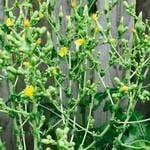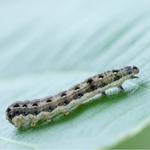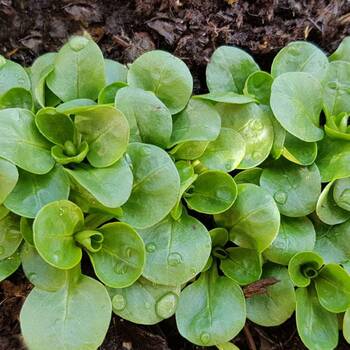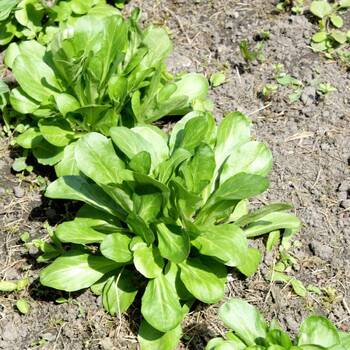
How to Grow Corn Salad Seeds
Grow Guide #2256
Family: Caprifoliaceae
Binomial name: Valerianella locusta
Life Cycle: Annual
This 'How to Grow' guide details everything a home gardener needs to know to plant, grow and care for Corn salad (Valerianella locusta).
When to Sow Corn Salad Seeds
Corn Salad is a cool season crop. Use the table below to identify the best time of year to sow corn salad in your climate.
| JAN | FEB | MAR | APR | MAY | JUN | JUL | AUG | SEP | OCT | NOV | DEC | |
|---|---|---|---|---|---|---|---|---|---|---|---|---|
| Cool | ||||||||||||
| Temperate | ||||||||||||
| Sub-Tropical | ||||||||||||
| Tropical | ||||||||||||
| Arid |
Preparation
Corn Salad plants are best grown in full sun or part shade. Choose a location that will receive at least 3 hours of full sun each day.
Corn Salad plants need a well drained soil enriched with plenty of organic matter. Prepare soil by weeding it thoroughly, digging it over to loosen it and adding aged animal manure or compost. Keep the area free of weeds until planting. Learn more about preparing soil for planting here.
Corn Salad plants can be grown in containers. If possible choose a variety that’s recommended for container growing. Use a good quality potting mix and make sure your container is large enough for mature plants; a minimum of 20 litres is recommended for corn salad. During the growing season, keep in mind that container grown plants may need additional fertiliser to encourage healthy growth.
How to Sow Corn Salad Seeds
Corn Salad seeds do not require any treatment (eg soaking, stratification) before sowing.
Corn Salad seeds can be sown directly into the garden OR seedlings can be raised in trays or other containers and transplanted to the garden once established.
Sow Direct
- Sow seeds directly in the garden 6mm deep and 20cm apart, with rows 30-45cm apart.
- Keep soil moist but never wet or dry.
- Seeds should germinate in around 7-12 days at a soil temperature of 10-20°C.
- Young seedlings will need protection from pests, pets and weather until they are established.
Raise Seedlings
- Fill trays, punnets or jiffy pots with a good quality seed-raising mix, or use soil starter pellets.
- Sow seeds 6mm deep.
- Keep soil moist but never wet or dry.
- Seeds should germinate in around 7-12 days at a soil temperature of 10-20°C.
- Transplant seedlings to the garden once they have their first true leaves and are large enough to handle (usually 5-10cm tall).
- Plant out, spacing plants 20cm apart, with rows 30-45cm apart.
Corn Salad is a cool season crop that will bolt in very hot weather. Do not transplant seedlings or sow seeds outside in very warm temperatures.
Tip: Corn Salad seeds can also be sown in the less formal ‘scatter seed’ method. Simply roughen the soil, scatter seeds evenly over the surface, then smooth the soil over lightly to cover the seeds.
How to Grow Corn Salad
Corn Salad plants may need watering during the growing season. Water when the soil is dry about 5cm below the surface (test this by scratching away a little soil with your finger). Water deeply in the early morning or late afternoon. Avoid watering the leaves of plants to avoid fungal diseases. Learn more about watering here.
If soil was well prepared no extra fertiliser should be necessary. In poor soil or to give your plants an extra boost, application of a high-nitrogen fertiliser or one formulated for leafy greens or herbs can be beneficial:
- Apply slow release fertiliser at the recommended rate when transplanting or when seedlings are 5-10cm tall.
- Apply liquid fertiliser at the recommended rate and frequency during the growing season.
Optional: To give plants room to grow, thin seedlings when they are large enough to handle. Pull out any weak or small seedlings so plants are spaced about 20cm apart.
How to Harvest Corn salad
Corn salad should be ready to harvest in approximately 45-60 days.
Corn salad is ready to harvest when the leaves are large enough to eat. Harvest the whole plant by cutting the stem at ground level. Corn salad can also be harvested as a 'cut and come again' crop by pinching or cutting a few outer leaves as needed, leaving some on the plant for future growth. Corn salad can be stored short term in a perforated plastic bag in the fridge.
Common Problems when Growing Corn salad
Like all plants, corn salad is susceptible to some pests, diseases and other problems. Below is a list of the most common problems gardeners encounter when growing corn salad plants:
 Aphids are small (2-4mm long) sap-sucking insects that congregate on the new shoots or the undersides of leaves. They can cause leaves to wilt or become discoloured, and also excrete honeydew which can attract ants and other insect pests. To manage aphids, remove them by spraying with a garden hose, apply a soap or alcohol spray, or encourage predatory insects to your garden. Read more about aphids here.
Aphids are small (2-4mm long) sap-sucking insects that congregate on the new shoots or the undersides of leaves. They can cause leaves to wilt or become discoloured, and also excrete honeydew which can attract ants and other insect pests. To manage aphids, remove them by spraying with a garden hose, apply a soap or alcohol spray, or encourage predatory insects to your garden. Read more about aphids here. Bolting is when a plant prematurely flowers and goes to seed. Bolting can be caused by a period of extreme weather. Avoid sowing seed until after the danger of frosts has passed or in very hot weather. Water plants regularly and deeply in hot weather to prevent them suffering heat stress.
Bolting is when a plant prematurely flowers and goes to seed. Bolting can be caused by a period of extreme weather. Avoid sowing seed until after the danger of frosts has passed or in very hot weather. Water plants regularly and deeply in hot weather to prevent them suffering heat stress. Cutworms are moth larvae that live in the soil, emerging at night to feed. The caterpillars are 3-4cm long and white, grey or brown in colour. They can chew through the stems of tender seedlings, felling them at ground level. Remove cutworms by hand at night or use cardboard collars to protect the stems of seedlings.
Cutworms are moth larvae that live in the soil, emerging at night to feed. The caterpillars are 3-4cm long and white, grey or brown in colour. They can chew through the stems of tender seedlings, felling them at ground level. Remove cutworms by hand at night or use cardboard collars to protect the stems of seedlings. Slugs and snails are molluscs that feed on tender leaves and shoots, mostly at night, leaving slimy trails behind them. Control them by removing their hiding places, keeping free range poultry, collecting them by torchlight or by placing traps. Read more about slugs and snails here.
Slugs and snails are molluscs that feed on tender leaves and shoots, mostly at night, leaving slimy trails behind them. Control them by removing their hiding places, keeping free range poultry, collecting them by torchlight or by placing traps. Read more about slugs and snails here.


.png)





